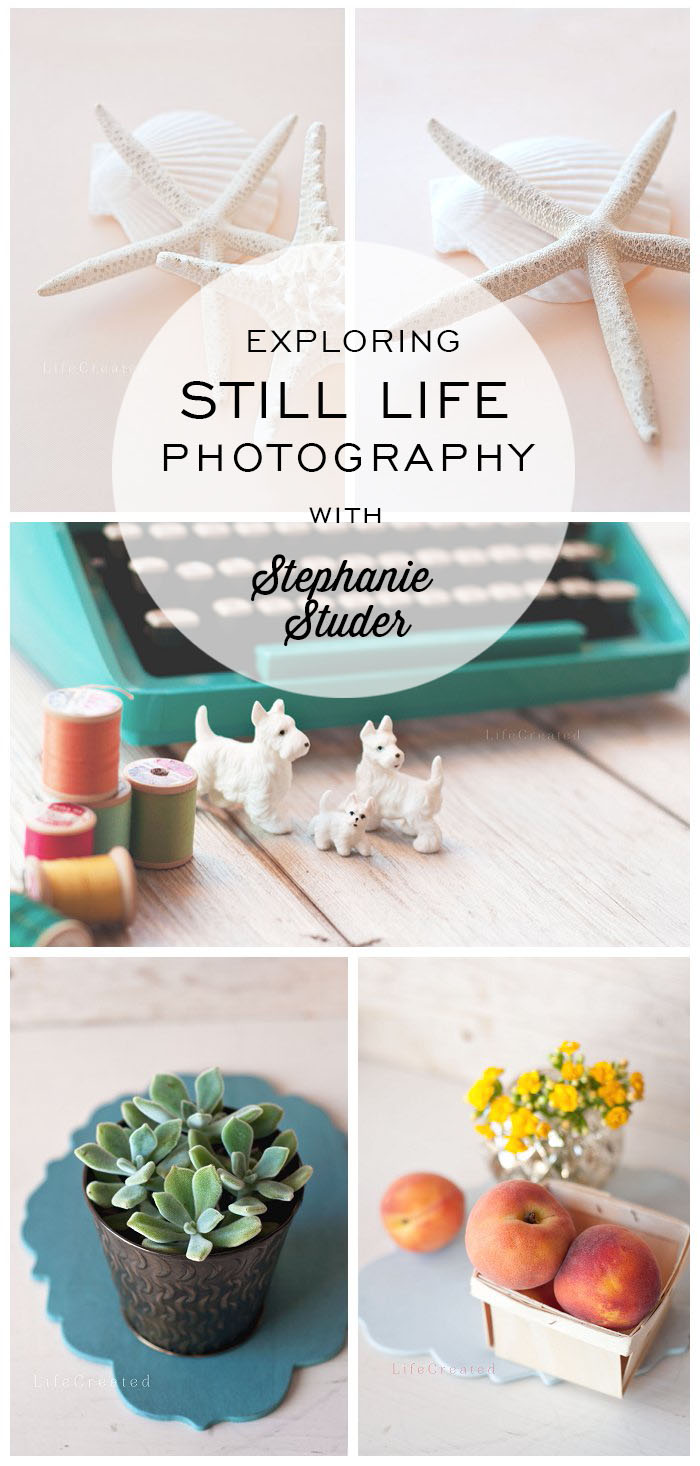Still life photography is so much more than taking pictures of stationary objects! Come along as we explore the ins and outs of still life photography with Stephanie Studer of Life Created.
Being still is foreign to me right now. I have a 5, 2 1/2. and 10 month old who are all mobile and traveling in different directions and paces at all times. Being still might happen if I hand over a bowl of grapes and turn on Mickey Mouse, but realistically, stillness is a rare occurrence.
I recently walked by a bookstore and there were people inside reading and drinking their coffees. They were actually able to sit in a chair alone… and read. WOW!
I know how readers love the way books can take them to another place and grow their minds. I believe photography can do the same…..art can do that.

When it is just me and a plate of food or “things” needing to be photographed, my mind has a tendency to run away. Ask my husband who has sat waiting for his plate of food he couldn’t eat until I took a picture of it…my “be back in a minute” can turn into twenty minutes super easily.
Our eyes and minds are unique to us, which is great when we go out in the world around us and find something new and different every time. A garden we walked through yesterday might hold new discoveries that our eyes didn’t find the day before. Maybe a vintage store’s shelves hold picture frames that look like tattered wood to someone else, but to you, they look like the frames your grandmother had in her kitchen.

More than just piling pasta on a plate, food and still-life photography is a great avenue for feeling light, connecting with the subject and setting the mood.
Feeling The Light

I’d much rather photograph a bowl of eggs than a 3 year old who likes to run away from me. My husband just sees “a bowl of eggs”, but I see more…the light and how it hits the eggs, each may be a different shade of brown and cream… spots that speckle their sides and the way their shape isn’t symmetrically oval.
In my workshops, I tell my attendees to pick a preferred place to shoot and monitor that spot for a day. Note where the light hits at different times so that you can adjust your shooting style accordingly. Having great light is key, and if you can’t find it in your house, try going outdoors.
The intensity and warmth of your light will change throughout the day, so ask yourself what light will coincide with the feeling you want your image to have.
Tools you can use to manage how the light hits your subject: For small items, consider using notecards or white piece of printer paper. Larger items can accommodate use of a reflector, sheer curtain, foam board, etc.
Connecting With the Subject
Photographing inanimate objects gives us time to interpret and feel what is happening before taking into account any technicalities and rules. This is one thing I love most about it!
Creating an image with feeling may require you to search inside a little before staging.
In my photography, I tend to drift in a vintage/kitchen/food style that utilizes natural light and styling. The kitchen is a place where a lot of memories are often made with families, so I find other people relate well. Maybe a kitchen is not your favorite place, so think of where you find comfort. How about the beach?
 When I see these images, I know they are the shells I picked out at the nautical shop in North Carolina when I was pregnant with my first baby. Her nursery was a coastal/fish theme and I wanted shells and such to decorate with. That was 5 years ago, and since then, they have traveled across the country, never breaking. I have thought of getting rid of them a few times, but always change my mind. We don’t live in that house anymore…it was a happy/sad time since we were experiencing deployment as well as birth of our first girl.
When I see these images, I know they are the shells I picked out at the nautical shop in North Carolina when I was pregnant with my first baby. Her nursery was a coastal/fish theme and I wanted shells and such to decorate with. That was 5 years ago, and since then, they have traveled across the country, never breaking. I have thought of getting rid of them a few times, but always change my mind. We don’t live in that house anymore…it was a happy/sad time since we were experiencing deployment as well as birth of our first girl.
You get the idea.
Connect with your subjects and you will enjoy it so much more. I believe when you are photographing things you love, it does show in the result.
Setting The Mood
If a shoot is pre-planned, you have time to contemplate the mood you want your image to have. The background and supporting props can help create that mood. Keep in mind, “supporting” props means only have extras that support the “hero” of the image. Limit distractions by using solid and/or neutral colors and no crazy patterns or clutter.
The mood of your image can also be solidified in how you edit your image. Clean edits with minor alterations are usually what I lean towards, and after time and practice, I know my style pretty well.

Whatever your skill level in photography, keep at it. Your style may change, and you may stumble upon a new style you had never considered before. Pick a fruit you have never eaten before and bring it home to photograph…make goals and don’t be afraid to fail. I truly believe with any art, you can never go wrong because there aren’t any limitations.
If you found this article helpful, or if you may be interested in any of my prints for sale, please contact me at [email protected] or follow me on Instagram @lifecreated and on Facebook.
Thank you so much Stephanie for these wonderful insights into still life photography and for sharing your gorgeous work with us!



I have just started reading more about photography. I know what style I like, its just a matter of learning how to get there and how to adjust my camera to the settings I need and want. Thanks for the great tips!!
Alyica//Crazily Normal
Beautiful pictures and GREAT tips!!
what a fun post – great tips, and it takes me back to my days of painting and studying still life. I need to do it more often to stay in the groove – thank you!
Thanks for the tips and inspiration. Love your photos!
I absolutelly love photographing still life and I want to thank you for sharing this content with us.